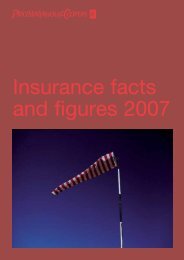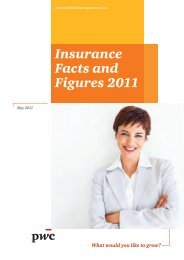Controlling fraud in the public sector - PricewaterhouseCoopers
Controlling fraud in the public sector - PricewaterhouseCoopers
Controlling fraud in the public sector - PricewaterhouseCoopers
You also want an ePaper? Increase the reach of your titles
YUMPU automatically turns print PDFs into web optimized ePapers that Google loves.
What’s on <strong>the</strong> <strong>fraud</strong> horizon?<br />
When asked about <strong>the</strong> most likely <strong>fraud</strong> threats<br />
<strong>in</strong> <strong>the</strong> follow<strong>in</strong>g 12 months, respondents from<br />
government and state-owned enterprises<br />
identified asset misappropriation, account<strong>in</strong>g<br />
<strong>fraud</strong> and bribery and corruption. These<br />
outcomes are hardly surpris<strong>in</strong>g, s<strong>in</strong>ce <strong>the</strong>y<br />
were <strong>the</strong> most commonly experienced <strong>fraud</strong>s<br />
dur<strong>in</strong>g <strong>the</strong> preced<strong>in</strong>g 12 months.<br />
However, 21% of respondents also felt <strong>the</strong>ir organisation<br />
was “quite likely” or “very likely” to experience <strong>in</strong>tellectual<br />
property <strong>in</strong>fr<strong>in</strong>gement (<strong>in</strong>clud<strong>in</strong>g loss of data) <strong>in</strong> <strong>the</strong> next<br />
12 months. The nature and extent of <strong>the</strong> personal data<br />
that government organisations hold makes <strong>the</strong>m a key<br />
target for <strong>fraud</strong>sters.<br />
Based on our experience work<strong>in</strong>g <strong>in</strong> this <strong>sector</strong>, we fur<strong>the</strong>r<br />
identify procurement <strong>fraud</strong> to be ano<strong>the</strong>r <strong>fraud</strong> risk on top<br />
of those reported <strong>in</strong> <strong>the</strong> ANAO report, which ranges from<br />
<strong>the</strong> tender process to <strong>in</strong>voic<strong>in</strong>g and payment. We are also<br />
<strong>in</strong>creas<strong>in</strong>gly work<strong>in</strong>g with clients <strong>in</strong> <strong>the</strong> corporate <strong>sector</strong><br />
on <strong>the</strong>ir proof-of-leave balances and leave taken. Employee<br />
leave is not be<strong>in</strong>g recorded or categorised properly and this<br />
is distort<strong>in</strong>g <strong>the</strong> <strong>in</strong>ternal f<strong>in</strong>ancial records. This is emerg<strong>in</strong>g<br />
as a new <strong>fraud</strong> risk <strong>in</strong> that environment and we expect to<br />
see it emerge <strong>in</strong> <strong>the</strong> <strong>public</strong> <strong>sector</strong> <strong>in</strong> <strong>the</strong> next few years.<br />
In response to <strong>the</strong>se ongo<strong>in</strong>g and emerg<strong>in</strong>g <strong>fraud</strong> risks,<br />
organisations must ensure <strong>the</strong>y take <strong>the</strong> steps necessary<br />
to ensure <strong>the</strong>y are well protected aga<strong>in</strong>st <strong>the</strong> most<br />
common types of <strong>fraud</strong> and regularly review <strong>the</strong>ir<br />
<strong>fraud</strong> risk assessments.<br />
Similarly, <strong>the</strong> ANAO report identified <strong>the</strong> follow<strong>in</strong>g<br />
ongo<strong>in</strong>g and emerg<strong>in</strong>g <strong>fraud</strong> risks:<br />
• unauthorised or <strong>in</strong>appropriate use of <strong>in</strong>formation<br />
technology<br />
• unauthorised access to and release of <strong>in</strong>formation<br />
• forgery or falsification of records<br />
• identity <strong>fraud</strong><br />
• outsourc<strong>in</strong>g of service delivery<br />
• <strong>in</strong>troduction of new policy <strong>in</strong>itiatives and programs<br />
• <strong>in</strong>troduction of <strong>in</strong>ternet-based transactions and<br />
electronic <strong>in</strong>formation exchanges.<br />
Figure 11: Perception of <strong>fraud</strong> <strong>in</strong> <strong>the</strong> next 12 months <strong>in</strong> government and state-owned enterprises<br />
Asset misappropriation<br />
33%<br />
Bribery and corruption<br />
23%<br />
IP <strong>in</strong>fr<strong>in</strong>gement <strong>in</strong>clud<strong>in</strong>g loss of data<br />
21%<br />
F<strong>in</strong>ancial statement <strong>fraud</strong><br />
10%<br />
0%<br />
5%<br />
10%<br />
15%<br />
20%<br />
25%<br />
30%<br />
35%<br />
Percentage of respondents<br />
Fight<strong>in</strong>g <strong>fraud</strong> <strong>in</strong> <strong>the</strong> <strong>public</strong> <strong>sector</strong> 19
















